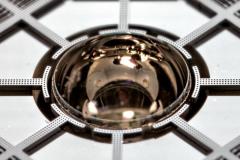William Tang Collaboration Receives Over $2.7 Million from DARPA
Research to be part of the Microscale Rate-Integrating Gyroscope program

William C. Tang, Ph.D., associate dean for research, and professor, Department of Biomedical Engineering with a joint appointment in the Department of Electrical Engineering and Computer Science, was awarded a grant of over $2.7 million by the Defense Advanced Research Projects Agency (DARPA) under the Microscale Rate-Integrating Gyroscope (MRIG) program. Dr. Alexander Trusov, project scientist in the Department of Mechanical and Aerospace Engineering and Dr. Karl Y. Yee, Jet Propulsion Laboratory, are collaborating with Tang.
Professor Tang will lead the three-year effort to pursue research on a precision rate-integrating micro gyroscope. Their approach to satisfying the DARPA requirement is based on several key technologies developed in the MicroSystems Laboratory under the leadership of Dr. Trusov.
The MRIG program seeks to develop technology needed to measure rotation over a wide range of dynamic conditions. Conventional technologies for microelectromechanical systems (MEMS) gyroscopes are based on structures with flat geometry made out of silicon with restricted fabrication tolerances. These technological drawbacks limit the performance of traditional MEMS gyroscopes, especially in environments with strong ambient vibrations and temperature changes.
Recently, the MicroSystems Laboratory introduced a new paradigm for wafer level fabrication of three-dimensional (3-D) spherical shell resonator gyroscopes. The approach is based on pressure and surface tension driven plastic deformation of the structural material for simultaneous creation of thousands of symmetric spherical shell resonator gyroscopes. Due to the inherently low surface roughness, high aspect ratio and applicability to new materials, the approach is expected to enable the realization of high precision 3-D MEMS transducers for communication and inertial navigation applications.
At the completion of the project, the developed sensors will become a critical part of the Inertial Measurement Unit (IMU), small and sufficiently low powered for adaptation in guided munitions' platforms, hand-held devices and add-in portable Guidance, Navigation, and Control (GN&C) units. This revolutionary technology will effectively eliminate the dependence on Global Positioning System (GPS) or any other external signals and enable uncompromised navigation and guidance capabilities for advanced munitions, various military platforms and individual combatants under a wide range of operating conditions.
